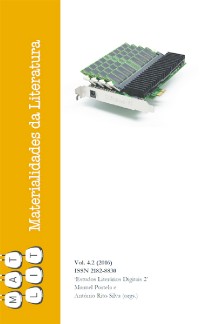Please use this identifier to cite or link to this item:
https://hdl.handle.net/10316.2/39096| DC Field | Value | Language |
|---|---|---|
| dc.contributor.author | Gemeinböck, Iris | - |
| dc.date.accessioned | 2016-07-19T10:09:07Z | |
| dc.date.accessioned | 2020-10-04T00:50:12Z | - |
| dc.date.available | 2016-07-19T10:09:07Z | |
| dc.date.available | 2020-10-04T00:50:12Z | - |
| dc.date.issued | 2016 | - |
| dc.identifier.issn | 2182-8830 | - |
| dc.identifier.uri | https://hdl.handle.net/10316.2/39096 | - |
| dc.description.abstract | Existem atualmente poucos corpora específicos de textos literários que estejam concebidos para servir as necessidades de críticos literários interessados na análise estilística de corpus de prosa ficcional. Muitos dos corpora de textos literários existentes foram compilados para efeitos de investigação linguística e, em muitos casos, não se adaptam aos objetivos da análise estilística de corpus. Este artigo aborda três dos principais problemas: a ausência de uma classificação dos textos por género literário, o uso de excertos e a prevalência de esquemas de periodização linguística. O CP18 é um corpus de prosa ficcional concebido para resolver aquelas limitações. Traça o desenvolvimento inicial do romance desde 1700 até à época Vitoriana. Pode ser utilizado, por exemplo, para análise das características linguísticas específicas de determinados géneros e formas literárias. Este artigo apresenta o desenho do corpus bem como alguns dos seus possíveis usos. | por |
| dc.description.abstract | Currently there are very few specialised corpora of literary texts that are tailored to the needs of literary critics who are interested in corpus stylistic analyses of prose fiction. Many existing corpora including literary texts were compiled for linguistic research interests and are often unsuitable for corpus stylistic purposes. The paper addresses three of the main problems: the absence of labelling of the texts for literary genre, the use of extracts, and the prevalence of linguistic periodisation schemes. C18P is a corpus of prose fiction designed specifically to address these issues. It traces the early development of the novel from 1700 up until the Victorian era. It can, for instance, be used for an analysis of the characteristic linguistic features of individual literary genres and forms. The following paper introduces the design of the corpus as well as some of its potential uses. | eng |
| dc.language.iso | eng | - |
| dc.publisher | Centro de Literatura Portuguesa | - |
| dc.publisher | Imprensa da Universidade de Coimbra | - |
| dc.rights | open access | - |
| dc.subject | corpus analysis | eng |
| dc.subject | corpus stylistics | eng |
| dc.subject | corpus building | eng |
| dc.subject | eighteenth century | eng |
| dc.subject | prose fiction | eng |
| dc.subject | representativeness | eng |
| dc.subject | análise de corpus | por |
| dc.subject | estilística de corpus | por |
| dc.subject | construção de corpus | por |
| dc.subject | século XVIII | por |
| dc.subject | prosa ficcional | por |
| dc.subject | representatividade | por |
| dc.title | Representativeness in corpora of literary texts: introducing the C18P project | por |
| dc.type | article | - |
| uc.publication.collection | Matlit v. 4, nº 2 | - |
| uc.publication.firstPage | 29 | - |
| uc.publication.issue | 2 | - |
| uc.publication.lastPage | 48 | - |
| uc.publication.location | Coimbra | - |
| uc.publication.journalTitle | MATLIT: Materialidades da Literatura | - |
| uc.publication.volume | 4 | por |
| dc.identifier.doi | 10.14195/2182-8830_4-2_2 | - |
| uc.publication.section | Secção Temática | Thematic Section | - |
| uc.publication.orderno | 2 | - |
| uc.publication.area | Artes e Humanidades | - |
| uc.publication.manifest | https://dl.uc.pt/json/iiif/10316.2/39096/264084/manifest?manifest=/json/iiif/10316.2/39096/264084/manifest | - |
| uc.publication.thumbnail | https://dl.uc.pt/retrieve/12079203 | - |
| item.fulltext | With Fulltext | - |
| item.grantfulltext | open | - |
| Appears in Collections: | Matlit | |
Files in This Item:
| File | Description | Size | Format | |
|---|---|---|---|---|
| representativeness_in_corpora_of_literary_texts.pdf | 732.93 kB | Adobe PDF |  |
Items in DSpace are protected by copyright, with all rights reserved, unless otherwise indicated.
